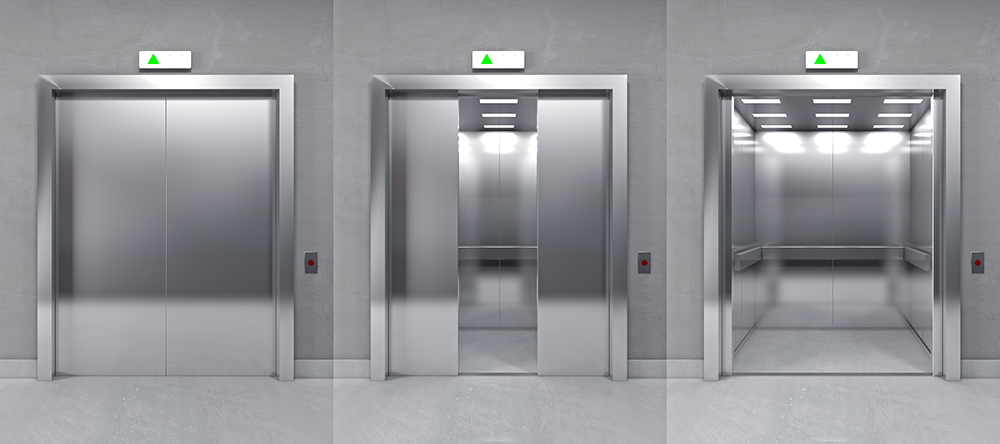The Only Way is Up…Or is it?

Lifts have played an important role in our cities’ development and many of our most iconic skylines would not exist without them.
In days of old, the first floor was the prime location in any building; it was away from the hustle and bustle of the pavements, but accessible via just one flight of stairs. Anything above the second floors was typically reserved for servants. Nowadays, it’s a completely different story…
With advances in lift technology, higher floors are more sought after, boasting impressive views and glamour, with penthouse accommodation becoming a status symbol. But have lift manufacturers reached the top of their game? Or can they climb even higher?
The Early Days
While hoisting equipment of some sort or another has been used for centuries (the Colosseum in Rome had twenty-four lifts powered by slaves), Erhard Weigel, a German mathematician, is reported as the first person to use an arrangement of boxes and ropes to navigate the floors of his home in the 17th Century. Later, Louis XV installed a counterweight lift to his private chamber is 1743.
The first public lift was introduced by Elisha Otis in 1854. Otis added a spring-loaded ratchet to the traditional box, rope and counterweight design, to stop the lift from falling if the rope was to break. The first public lift was installed three years later in E.V. Haughwout and Company, a five-storey porcelain shop in the SoHo neighbourhood of Manhattan, New York. While the lift wasn’t necessarily required to scale the five-storey building, Haughwout knew that the novelty would attract new customers to his shop. The lift was powered by a steam engine in the basement and travelled at a speed of 0.2m/s. However, it was not received well – the public were too afraid to ride the new device and it was removed in 1860.
As buildings got taller, largely thanks to the introduction of steel-frame structures, lifts became more of a necessity. However, they mostly used hydraulics and were pushed up from underneath by a piston. This method was much faster than Otis’ steam-driven lifts, but required the piston to be sunk below the ground to a depth that matched the height of the lift shaft. While not impossible for sub-twenty-storey buildings, it was not without its limitations.
Following the introduction of electric motors, lift speed soared to more than 2m/s. The first steel-frame building to expand across fifty floors was opened in 1913 with electrified lifts travelling at more than ten times the speed of earlier, steam-powered efforts. Twenty-years later the Empire State Building, the first to have more than 100 floors, was installed with elevators that travelled at 6m/s, speeds similar to those we see today.
Continued Development
An appetite for higher and faster lifts has driven development in recent years. Reducing the time it takes to get to your destination is the key to developing any method of transport. Lifts typically travel at around 8m/s. Mitsubishi’s lifts in the Shanghai tower travel at more than double that and reach speeds up to 20m/s (45 miles per hour!) but while the users value speed, they struggle to cope with the acceleration that comes with it.
Due to the discomfort of vertical acceleration, lifts can only reach their top speed over long, uninterrupted journeys. Therefore, the quest for speed now lies in efficiency; the time it takes the doors to open and close, and the number of unnecessary stops and empty journeys that a lift makes – all of which impact door-to-desk time.
Double-decker lifts, which serve odd and even floors simultaneously, and destination control, where the lift system tells the user which lift to use to maximise their efficiency, are all helpful developments. Some have introduced a sky lobby, i.e. where two lifts share the same shaft, but one just serves the first twenty-five floors and the other services the floors above.
Limitations
The longer a steel cable is, the heavier it becomes. Over hundreds of metres, steel cable gets so heavy that it may not even be able to bear its own weight without snapping. Kone, a Finnish liftmaker, developed UltraRope made from carbon fibre to get around this, making lift shafts of more than 600 meters possible. ThyssenKrupp, a German engineering conglomerate, is testing a way to do away with cables altogether. The company, which also makes railway equipment, has utilised the power of high-speed railway technology to create Multi, a system held in place and propelled by electromagnetic forces, similar to that used for magnetic-levitation trains.
Multi aims to remove the height limitations of cables altogether.
The Only Way is Up… Or is it?
By eliminating cables, lifts will be able to move laterally as well as vertically. Lift shafts will be able to fork and rejoin allowing lifts to overtake or move out the way of faster moving lifts.
With systems like Multi, the number of cars in the system can be changed on the fly to suit demand, making them more energy efficient. Liftshafts will be smaller, allowing for more space, and architecture can evolve to have more curves, be more circular and not have to focus around the central core of a lift shaft.
Most excitingly, lateral moving lifts could link whole clusters of buildings, connecting one building to another via skybridges or skyways, helping buildings to spread horizontally as well as vertically.
2EA® are registered Low Carbon Energy Assessors, Consultants and ESOS Lead Assessors, offering both energy management and reduction services ranging from CCL/CHPQA Management to Energy Saving Opportunity Scheme (ESOS) and Carbon Reduction Commitment (CRC) consultancy.
For more information, please contact us either by email to info@2ea.co.uk or by calling 01293 521 350.
Source: https://www.economist.com/news/christmas-specials/21732705-elevators-may-soon-go-sideways-well-up-new-lift-technology-reshaping-cities


